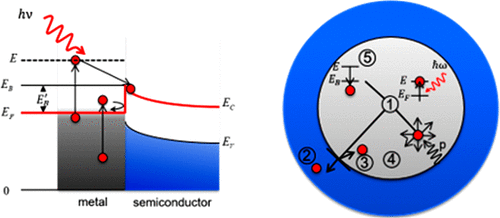当前位置:
X-MOL 学术
›
ACS Photonics
›
论文详情
Our official English website, www.x-mol.net, welcomes your feedback! (Note: you will need to create a separate account there.)
Limit of efficiency of generation of hot electrons in metals and their injection inside a semiconductor using a semiclassical approach
ACS Photonics ( IF 7 ) Pub Date : 2018-07-12 00:00:00 , DOI: 10.1021/acsphotonics.8b00473 E. Blandre 1 , D. Jalas 1 , A. Yu. Petrov 1, 2 , M. Eich 1, 3
ACS Photonics ( IF 7 ) Pub Date : 2018-07-12 00:00:00 , DOI: 10.1021/acsphotonics.8b00473 E. Blandre 1 , D. Jalas 1 , A. Yu. Petrov 1, 2 , M. Eich 1, 3
Affiliation

|
Hot electron generation in a metal and injection into a semiconductor is a crucial mechanism to convert sub band gap photons into free electrical charges inside a semiconductor. This process is of paramount importance for solar photocatalysis since the semiconductors involved often have a band gap too large for direct excitation with sun light, thus requiring a carrier transfer from an adjacent effective absorber, which in our case is a metal, to the semiconductor in order to initiate the envisaged photochemical reactions. Single interaction of a hot electron with a metal–semiconductor boundary is described by Fowler’s law. In nanometer sized metals hot electrons, before they lose their energy, can interact several times with the boundary, which increases the probability of injection. To understand the efficiency of this process, to find ways to optimize it, and to determine its limits, an electron transport model based on a Monte Carlo approach is proposed. The numerical calculations provide an in-depth understanding of the impact of size and shape of the metal on the injection efficiency. Values are obtained that exceed the usual efficiency limits described by Fowler’s theory.
中文翻译:

使用半经典方法限制金属中热电子的产生效率以及它们在半导体内部的注入效率
在金属中产生热电子并注入半导体是将子带隙光子转换为半导体内部自由电荷的关键机制。该过程对于太阳能光催化至关重要,因为所涉及的半导体通常具有太大的带隙,以至于无法用太阳光直接激发,因此需要将载流子从相邻的有效吸收剂(在我们的情况下是金属)转移到半导体中。为了引发设想的光化学反应。福勒定律描述了热电子与金属-半导体边界的单次相互作用。在纳米级金属中,热电子在失去能量之前可以与边界相互作用多次,从而增加了注入的可能性。要了解此过程的效率,为了找到优化方法并确定其极限,提出了一种基于蒙特卡洛方法的电子传输模型。数值计算可深入了解金属的尺寸和形状对注射效率的影响。获得的值超过了福勒理论所描述的通常的效率极限。
更新日期:2018-07-12
中文翻译:

使用半经典方法限制金属中热电子的产生效率以及它们在半导体内部的注入效率
在金属中产生热电子并注入半导体是将子带隙光子转换为半导体内部自由电荷的关键机制。该过程对于太阳能光催化至关重要,因为所涉及的半导体通常具有太大的带隙,以至于无法用太阳光直接激发,因此需要将载流子从相邻的有效吸收剂(在我们的情况下是金属)转移到半导体中。为了引发设想的光化学反应。福勒定律描述了热电子与金属-半导体边界的单次相互作用。在纳米级金属中,热电子在失去能量之前可以与边界相互作用多次,从而增加了注入的可能性。要了解此过程的效率,为了找到优化方法并确定其极限,提出了一种基于蒙特卡洛方法的电子传输模型。数值计算可深入了解金属的尺寸和形状对注射效率的影响。获得的值超过了福勒理论所描述的通常的效率极限。



























 京公网安备 11010802027423号
京公网安备 11010802027423号